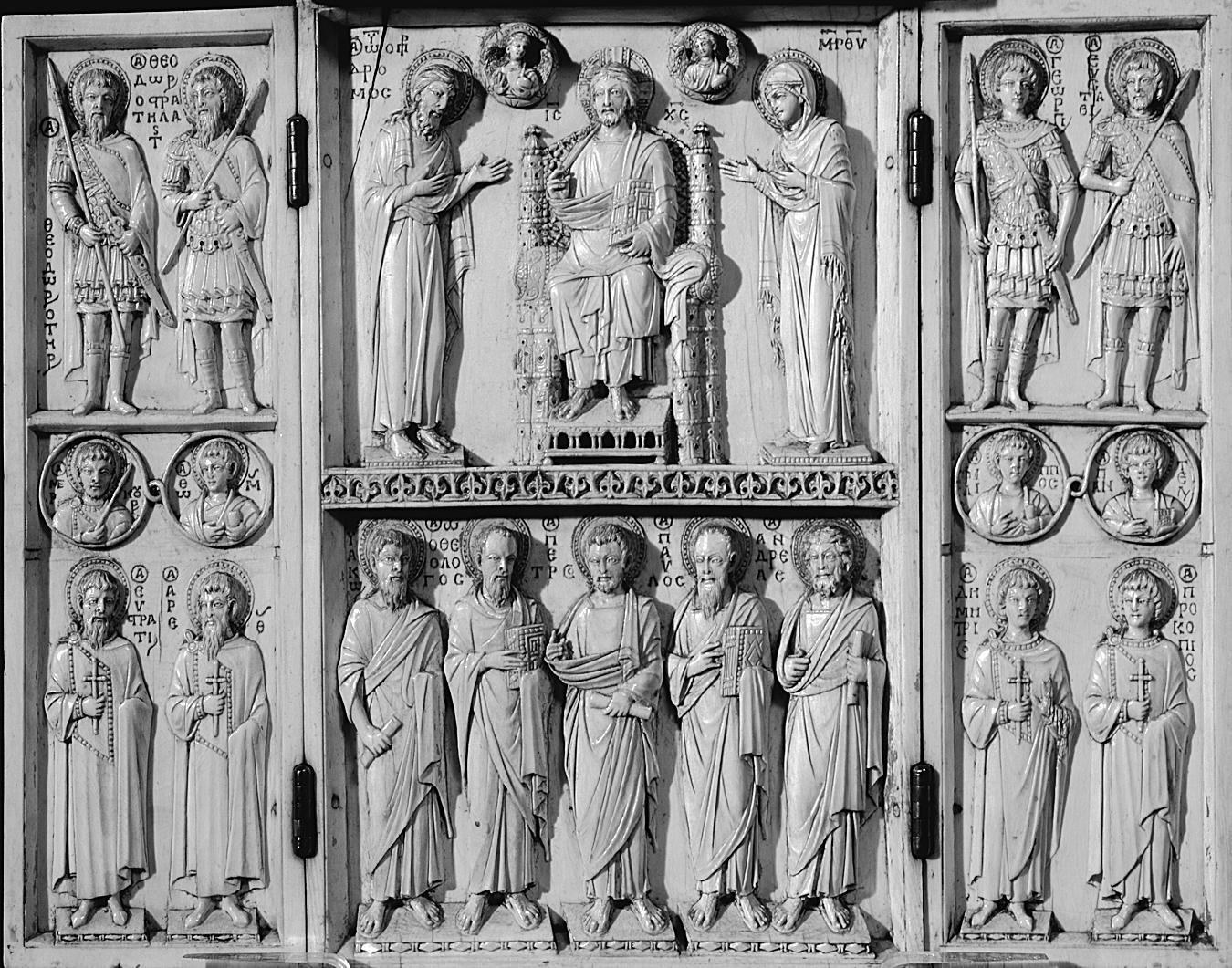3. The Macedonian Renaissance
Harbaville Triptych (c. 950)
His contempt aside, at the time of Liutprand of Cremona’s visit, the Byzantine Empire was thriving. Ongoing military success had expanded its borders while infusing the imperial court with new wealth and power. Among the most striking features of the empire’s vitality was a surge in artistic activity aimed at reviving the glory of Byzantium’s past. With the iconoclastic period firmly behind them, the emperor and the local elite sponsored artists to craft Christian icons for both private and public worship. They, like ordinary Byzantines, believed icons were more than images; rather they were physical manifestations of the holy people they depicted and as such, possessed sacred power. The Harbaville Triptych is typical of Byzantine art in this period. Carved in ivory and intended for personal devotion, the triptych comprises a center panel and two wings that open and close. This design allowed for easy transport. When open, as it would have been when in use, the triptych measures nine and a half by eleven inches. The center panel is divided into two registers. At the top is a representation of Christ enthroned, with the Virgin Mary and Saint John the Baptist at his side as intercessors for humanity, a popular Byzantine image called the Deesis. Below them stand five more saints, including St. Peter whose finger is pointed to draw the viewer’s eye to Christ. Each inner wing panel includes two pairs of standing saints and one pair of saints in medallions. All four standing saints in the upper register are military saints, as their style of dress and attributes reveal. The saints in the lower register all bear a martyr’s cross and wear a courtier’s costume; this choice was customary for works connected to imperial circles. The names of the saints appear next to their heads.

DISCUSSION QUESTIONS
- Look closely at the human figures in the triptych. How would you describe them stylistically in terms of their shape and their clothes? Why do you think the sculptor paid such close attention to these details?
Question
KxjvXyoMCw4AHV3oc0SzPpQ+Aeunr4EfJzGtJP9xKSDXrmig9/Q9sPa0ifS+2fod1kp/V4Ncu3zw0LHUdidapq30MhyTF4QNsy7QCkLOvc2ZYxDojV5e4M/zIa8Eyi6kngw9A0HGVLpoLwEDY5JIYjSItrxeFR6OB3ERK5+qQSEJlvKBfisCbMR6Mp5Mq2FzcV+na/PkRjpoudik3usN58ENG3i/m/7GeXFNee9yr/YJ/jEcgQCguyw0pRLYrtiPwQ2l4MjrY7qgu30ji+wZZoMcqWqhhDL+QBkRGzfSR8RaqV2LmL8Gv1aYAVmh6EXOCCON8o+oR1kxjjaxLook closely at the human figures in the triptych. How would you describe them stylistically in terms of their shape and their clothes? Why do you think the sculptor paid such close attention to these details? - What effect do you think the overall composition and arrangement of the triptych may have had on viewers at the time? What do both suggest about the importance of icons in Byzantine society?
Question
i0Psjwc55pUAWtJTQ+h8xIFS1yh6/PgH7JYkqK2acS8HtK33NbsliCMKgn6ZhBiN946b+eAmcMQ058r0xGZLP8KNQXwdu/dqx8wDZ9jmqPtckN3szgwOhtLg8ir3gwxiMAV/pQ5o17UFIqTF7bKg9soiDdI3hc9p+ZdUcRPfS3yTU5n9iCbwTgFZnU6EriJvNHN12vC17dUZIYSd6+Tv+T6FJgQNhnBfStYrS81wh0kI+OkhfPuQcoWRxe5uY6K7cospjl1aiHd8WSpFYQBjo681G34Tky1C9/GLOswc5R1I5Ayt4V/O5Q==What effect do you think the overall composition and arrangement of the triptych may have had on viewers at the time? What do both suggest about the importance of icons in Byzantine society? - In what ways does the piece reflect the empire’s newfound wealth and confidence in the tenth century?
Question
uGLsZJwh2KR0/pSsqBKy91KXCZDVpjyrFcDYMhS+8nQijbN07W4ZE9m1AFLpA7EZHdbJai7Wqyv47ckKAD7Y2FPlqzS2FViY6A7LD9gdtJYoAHKRa71dTpk2Cv58SF9YQEkc0YhsbrLggIb2sxtuiSeGxU5Bt73SEE+V8lDAGhQmYRg7NdUzDZKDnEbQG6sX5Z3Pvg==In what ways does the piece reflect the empire’s newfound wealth and confidence in the tenth century?